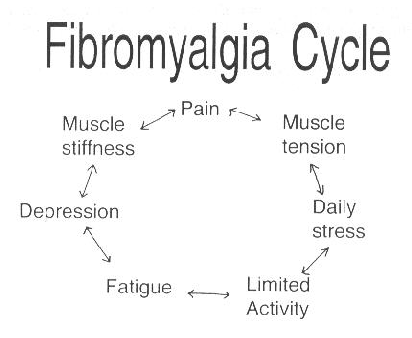« Hiatal Hernia | Main | Whooping Cough »
Fibromyalgia
Fibromyalgia is a chronic disease, often debilitating, defined solely as a constellation of signs and symptoms characterized by diffuse pain, and fatigue. It is not contagious.
Fibromyalgia is seen in 3-10% of the general population, and is mostly found between the ages 20 and 50, in women more often than men. The nature of fibromyalgia is not well understood, and there is no western medical cure, though it can be managed. There are many complimentary and alternative therapies available including acupuncture, herbal medicine, and dietary therapies.
fibromyalgia symptoms
Not all patients display all symptoms of fibromyalgia. The primary symptoms include:
- Widespread, diffuse pain, often including heightened sensitivity of the skin
- This pain is seen both in the skin and muscles.
- It is described as both aching and soreness.
- Often times subtle stimulation to the skin such as the act of wearing clothing can cause extreme pain.
- Achiness around joints
- Unlike arthritis, fibromyalgia does not cause swelling.
- Deformity in the joints is also not a sign of fibromyalgia. Rather, deformity of the joints would be indicative of osteoarthritis.
- Nerve pain
Other possible fibromyalgia symptoms
 These symptoms are often associated with fibromyalgia but may be due to other comorbid disorders. These symptoms include:
These symptoms are often associated with fibromyalgia but may be due to other comorbid disorders. These symptoms include:
- fatigue
- irritable bowel syndrome (IBS)
- genitourinary symptoms
- dermatological disorders
- headaches
- symptomatic hypoglycemia
Although it is common in people with fibromyalgia for pain to be widespread, it may also be localized in areas such as the shoulders, neck, back, and hips.
Fibromyalgia symptoms may start as a result of trauma (such as a traffic accident) or illness, but there are no strong correlation between any specific type of trigger and the subsequent initiation of fibromyalgia.
Symptoms can have a slow onset, and many patients have mild symptoms beginning in childhood such as growing pains. Signs and symptoms of fibromyalgia are often aggravated by unrelated illness, or changes in the weather. They can become more tolerable or less tolerable throughout daily or yearly cycles.
Many people with fibromyalgia find that, at least some of the time, the disease prevents them from performing normal activities such as driving a car or walking up stairs. The syndrome does not cause inflammation as is presented in arthritis, nor are there any diagnostically abnormal laboratory findings.
Symptoms of fibromyalgia may present periodically or may be continual.
fibromyalgia diagnosis
When making a diagnosis of fibromyalgia, a practitioner would take into consideration the patients case history and the exclusion of other conditions such as endocrine disorders, arthritis, and polymyalgia rheumatica. There are also two criteria established by the American College of Rheumatology for diagnosis:
- A history of widespread pain lasting more than three months. Widespread, as in all four quadrants of the body, i.e., both sides, and above and below the waist.
- Tender points. There are eighteen designated possible tender points (although a person with the syndrome may feel pain in other areas as well). During diagnosis, four kilograms of pressure is exerted at each of the eighteen points; the patient must feel pain at eleven or more of these points for fibromyalgia to be considered. This technique was developed by the American College of Rheumatology as a means of confirming the diagnosis for clinical studies. It is also used in the United Kingdom. Unfortunately, while the vast majority of fibromyalgia patients express pain when these points are pressed, a few patients with a high pain tolerance may not feel exceptional pain during the test.
Posted by Staff at June 17, 2005 7:00 PM
blog comments powered by DisqusComments Archive
I was recently diagnosed with Fibromyalgia. I felt it was a cop out diagnosis. There was definitely NO 18 point test done. I was allotted only 10 minutes for a $60 prepaid appointment, because I do not have medical insurance. The week prior to the appointment, I forwarded multiple test results to the physician which included blood work, MRI,DMX, and static x-rays, along with a history. It was obvious none had been reviewed. A year earlier I was in a head on car accident with a 17 year old boy who had his license for 3 hours. He was on my side of the road and admitted to being on prescribed drugs that he thought may have made him fall asleep. As a result of that accident I have the following:
Cervical Strain / Sprain Injury / Lordosis
Upper Cervical Subluxation Complex
Lumbar Spine Subluxation
Joint Dysfunction at multiple levels with Secondary Spinal Arthrosis
Ligamentous Laxity in the Cervical Spine
The MRI revealed a possible obstruction in the nerve opening at C2-C3 and a mild disk bulge at C5-C6.
The DMX revealed at C2 there is a 4.76 loss of motion integrity while the atlas shifts from 2.03mm to 3.02mm.
I scheduled the appointment because I have intermittent loss of hearing. I fall to the ground staggering as in a drunken stupor. I "come to" while driving and am not sure where I am until I can find a road sign. I cannot recall information; I know that I know the answer to. I ache.
With the packet that I sent ahead, I suggested that perhaps my vertebral artery might be being pinched due to my shifting atlas and C2. I still think this is the problem.
Without insurance, I can't get anybody to pay attention to me . . .
Posted by: Kate at January 5, 2006 4:57 PM
my left rip cage feels warm the skin is tender I put a piece of ice on it didnt feel the cold just pain tryed right side just felt cold ,left thigh same way
Posted by: sonny at March 14, 2006 1:46 AM

